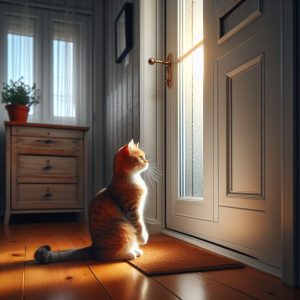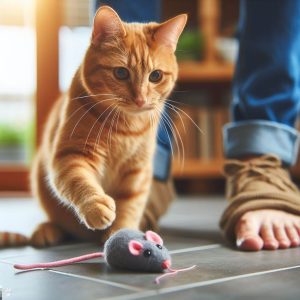Are you looking for a fun DIY project that will thrill your favorite feline friend? Building your own cat tree using recycled materials is a purrfect way to create a customized play space for your cat while saving money and repurposing unwanted items. With a little bit of creativity and effort, you can construct a sturdy, multi-level cat tree that will provide hours of entertainment and exercise for your pet.
In this comprehensive guide, you’ll learn everything you need to know about crafting a one-of-a-kind cat tree from scratch. We’ll cover tips for sourcing recycled materials, building a solid base and frame, adding fun platforms and accessories, and customizing the tree for your cat’s personality. Follow along to give your kitty the gift of a stimulating cat tree without breaking the bank!
Why Build Your Own Cat Tree?
Purchasing a premade cat tree from a pet store can be quite expensive, with costs ranging from $50 to over $200. Constructing your own using recycled goods allows you to:
- Save money – Recycling scrap materials and objects from around your home cuts down on costs substantially.
- Create a custom design – Build a tree tailored exactly to your cat’s abilities, preferences and your space constraints.
- Repurpose unwanted items – Give new life to materials destined for the landfill.
- Spend quality time with your cat – The process of creating the cat tree offers fun bonding time.
- Provide stimulating activity – A multi-level tree with lots of features promotes exercise and entertainment.
As long as safety is kept in mind during construction, do-it-yourself cat trees offer an affordable and rewarding alternative to store-bought options. Your cat will be thrilled with their new customized kingdom!
Planning Your DIY Cat Tree Design
Before gathering supplies and starting construction, take time to plan out the design for your cat tree. Keep the following considerations in mind:
- Space available – Make sure the tree will fit comfortably in the room. Measure to ensure adequate ceiling height.
- Cat’s abilities – Consider your cat’s jumping power, agility and age. Older or less nimble cats may need shorter distances between platforms.
- Cat’s preferences – Note the height, materials, and types of surfaces your cat seems to enjoy. Customize platforms and accessories accordingly.
- Aesthetic – Determine the overall look and style. Aim for visible stability and a balanced appearance.
- Number of cats – If multiple cats will use the tree, make it sturdy enough to handle their play. Provide sufficient space.
Take measurements of the area where the tree will be located. Sketch designs on graph paper, indicating heights, shapes, and planned materials. Start simple, then add complexity once the basics are complete. It’s easy to make future modifications as your build evolves.
Gathering Recycled Building Supplies
One of the most exciting parts of making a DIY cat tree is scavenging for recycled items to repurpose. Get creative as you hunt down usable materials from around your home, neighborhood and local businesses.
Great options include:
- Cardboard – Free, tube-shaped concrete forms make sturdy posts. Corrugated cardboard works for platforms.
- Carpet and fabric – Check for unwanted carpet remnants, old towels, jeans, t-shirts, blankets and upholstery scraps.
- Wood – Leftover plywood, 2 x 4s, timber pieces, crates, and boards make structural parts. Sand and stain to finish.
- Sisal rope – Wrap this natural fiber around posts and boards for scratching. Purchase inexpensive sisal mats and cut into strips.
- PVC – Plastic piping purchased at hardware stores allows adjustable platform heights.
- Miscellaneous – Bottle caps, corks, and fabric scraps become toys. Use old planters or baskets for hideaway cubby holes.
Talk to neighbors, check community and online classifieds and contact carpet/flooring companies for free or cheap materials. Collect more than you need to allow for flexibility as you build.
Constructing a Sturdy Base
The base establishes the fundamental structural integrity of the entire cat tree. It must be extremely stable and able to stay grounded as cats leap on and off from the highest perches.
Follow these steps to build a solid base:
- Cut a square plywood platform about 18-24 inches wide. 3/4 inch plywood is sufficiently thick and sturdy.
- Attach triangular gussets made of 2 x 4 lumber at the underside corners to reinforce the base. Predrill and screw in place.
- Measure and mark locations for vertical posts on top of the platform. Space widely enough for good stabilization.
- Place a stack of bricks or pavers on the platform to weigh it down. Position in a low-traffic area against a wall for added security.
- Cover the plywood with carpeting, securing underneath with staples, adhesive or tacks. Provide extra traction by attaching sisal rope squares.
- Outline the post locations on top of the carpeting so they remain visible for installation.
The weighted base gives your cat tree the solid foundation needed to support vigorous cat activity without toppling over. Take your time to construct it properly right from the start.
Adding Sturdy Posts
The vertical posts provide the essential supports that uphold the platforms and accessories. They must be tall enough to fit your planned height while remaining perfectly straight to prevent structural instability.
Follow this process for installing strong, centered posts:
- Cut posts to the needed height from materials like 2x4s, PVC pipe, concrete forms or sturdy cardboard tubes.
- Mark the post center points on the base platform. Predrill holes slightly smaller than the posts.
- Insert the posts into the holes and use wood glue to adhere in place. Let the glue dry completely.
- Check that posts are perpendicular to the base using a level. Temporarily brace with blocks if needed while drying.
- Place posts at least 16 inches apart for best stability. Use three or more posts spaced widely.
- Wrap sisal rope around posts up to kitties’ scratching height. Staple the ends securely.
Assembling sturdy, well-positioned posts prevents the cat tree from becoming rickety or collapsing over time. Don’t rush this vital step.
Adding Fun Platforms and Hiding Spots
Once the fundamental base and post construction is complete, the fun truly begins! Now you can customize by adding interactive platforms, cozy hideaways, and toys to delight your cat.
Platforms
Spacious platforms at varying heights provide cats with vantage points for play, lounging and cat naps.
- Cut plywood or cardboard into circles or squares of different sizes to make platforms.
- Cover platforms in carpeting or other fabrics for added traction and comfort. Secure underside with staples or adhesive.
- Attach platform levels to posts using brackets or notches cut into posts. Ensure extreme stability and support for jumping cats.
- Include both enclosed platforms with low railing and open platforms. Avoid high barriers that obstruct descending.
- Place platforms low enough for easy access by less agile cats. Gradually increase heights on higher levels.
Hideaways
Cats adore enclosed spaces that allow them privacy to nap and observe surroundings while feeling safe and cozy.
- Cut holes into cardboard boxes or wood crates to create hideaway cubbies. Ensure ample room for entry and exit.
- Line cubby interiors with soft fabrics like old T-shirts, towels or blankets for comfort.
- Attach cubbies securely to platforms using hot glue or other adhesives safe for cats.
- Add strategically placed peep holes or openings so cats can peek out.
Toys
Toys integrated into the design encourage valuable exercise, stroking cats’ predatory instincts.
- Hang ping pong balls, feathers, soda can tabs, corks or pom poms from posts and platforms with string. Vary heights.
- Secure an old shoe lace or fabric strip to dangle and swing for chasing and pouncing.
- Glue wine corks, bottle caps or buttons onto platforms and posts to bat around.
- Attach a small scratching pad, cardboard squares or old welcome mats to platforms for scratching.
Let your imagination run wild! Design playful features to match your cat’s personality. Change, add and expand components over time to continually pique their interest.
Customizing Your Cat Tree
Part of the fun of DIY cat trees is customizing features to match your cat’s unique preferences. Observe how they interact with different components to make your tree irresistible:
- Use plush carpeting or rubber mats on surfaces if they refuse to step on certain textures.
- Lower or raise platform heights based on ease of jumping and descending.
- Add more posts or cross braces if wobbling occurs for added stability.
- Increase cubby hole sizes if they seem cramped or crowded for your cat.
- Offer a range of hanging toys at different heights to test their agility and interest.
- Try diverse scratching materials like sisal, cardboard and wood. See which attracts repeated scratching.
Adapting the tree to your cat’s needs, skills and inclinations will ensure they take full advantage of the equipment you’ve worked so hard to build!
Safety First! Checking for Hazards
Before letting your cat enjoy their new tree, thoroughly inspect all elements to guarantee safety. Watch out for:
- Loose, wobbly or unstable components. Reinforce as needed.
- Exposed nails, staples or sharp edges. Add protective caps.
- Toxic paints, wood finishes or adhesives. Use non-toxic versions suitable for pets.
- Insufficient ceiling height. Platforms shouldn’t touch ceilings or light fixtures to avoid accidents.
- Overcrowding if multiple cats will share the tree. Ensure ample space.
- Accessibility of each resting spot. Cats should easily ascend and descend all levels.
- Adequate railing around high platforms. Avoid falls.
Make all needed final reinforcements and modifications. Only permit cat access once completely confident of full safety. Their wellbeing is the top priority!
Getting Kitty Accustomed to Their New Domain
You’ve successfully built a fantastic cat tree masterpiece using recycled products! Now comes the fun part – introducing your cat to their new playground equipment. Follow these tips for making a smooth transition:
- Initially place treats and catnip on platforms and inside hideaways to attract them.
- Start with lower sections and gradually coax upward as they gain confidence.
- Temporarily restrict access to other resting spots to build a new habit.
- Play with string toys or laser pointers around the tree to prompt exploration. Reward with praise and treats.
- Add their favorite napping blankets and toys to surfaces so the tree smells familiar.
- Vertical scratching posts help define this as a claw-worthy space. Rub with catnip.
With patience, your cat will soon claim their customized tree as their favorite hub for play, exercise, scratching and lounging the day away. Have fun witnessing the excitement unfold!
Get Creative and Build On!
One of the best aspects of DIY cat trees is that you can always modify, upgrade and expand them in the future as your skills grow. Here are some ideas for enhancing your original creation:
- Add higher levels with more daring jumps for agile cats.
- Extend existing posts upward to raise the tree and add more platforms.
- Build enclosed “caves” on platforms or suspended from posts.
- Add accessories like ramps, poles, branching limbs or tunnels.
- Use it as a foundation to build an entire cat “playground”.
- Freshen carpeted areas with new fabric as old coverings wear out.
Dream big and get innovative with your designs! Changing elements keeps the tree interesting. Constructing a unique cat tree using repurposed materials provides great DIY satisfaction. Best of all, you get to witness beloved cats delightedly reaping the rewards. Building the perfect cat tree takes some effort, but the investment of time and energy ends up being well worth it.
Key Takeaways on Constructing a DIY Cat Tree
- Plan designs ahead of time around available space, cat’s abilities, preferred accessories, aesthetics and structural needs.
- Scavenge creative recycled materials like cardboard, wood, carpet scraps, fabric, sisal rope and PVC piping.
- Build an extremely sturdy, weighted base as the foundation.
- Install tall, straight posts perpendicular to the base. Wrap sisal rope around for scratching.
- Add fun platforms of varying heights and shapes covered in carpet for traction.
- Incorporate interactive toys like dangling objects, scratch pads and tunnels.
- Customize features based on your cat’s personality and skills to maximize engagement.
- Check carefully for any hazards before allowing cat access. Prioritize safety.
- Tempt cats to explore and establish new habits through treats, catnip and play.
- Expand and modify the tree over time to add novelty and excitement.
- Bond with cats while providing stimulating activity and saving money by repurposing household items.
Building your own cat tree is an extremely rewarding do-it-yourself adventure. Follow the tips in this guide to create a customized recycled cat tree that both you and your feline friends will enjoy for years to come. Happy building and may your cats have a “purrfect” new playground!



